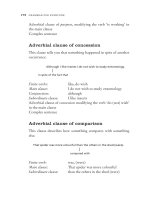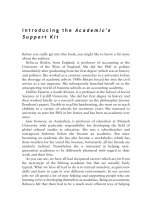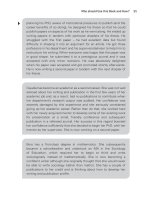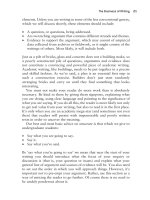Tài liệu Writing for Publication part 8 docx
Bạn đang xem bản rút gọn của tài liệu. Xem và tải ngay bản đầy đủ của tài liệu tại đây (103.19 KB, 10 trang )
written something experimental or unconventional, there is little
point in sending it to a journal that does not and will not include
that kind of writing.
4. Look at the list of editors and the editorial board to see whether the
people included do your kind of work or are interested in it. Some
journals also publish an annual list of people not on the editorial
board who have reviewed papers for them. It’s worth looking
at this to see what kinds of people are receiving the papers. Don’t
send a paper to a journal that regularly uses reviewers who might
be unsympathetic to your work and/or your area.
5. There are a number of practical issues to which you must also pay
attention. For instance, journals accept articles of different lengths.
Some want very short submissions while others are prepared to
accept much longer articles. This will be stated in the guidelines for
authors inside the back or front cover of the journal and on their
web page. Failure to heed these guidelines makes editors very
grumpy.
6. Journals have different turn-round times for the refereeing process
and lead times for publication when accepted. Sometimes this
information appears in the journal itself as a footnote to each
paper. There are a number of complex factors that impact on lead
times. The vagaries of research quality assessment exercises can
mean that there is a rush to publish before the exercise deadlines,
swamping journals. Sometimes editors seek to cluster papers that
they think fit well together. Putting an edition of a journal together
can be a complex jigsaw puzzle, especially as editors are limited in
the number of pages they are allowed to have in each issue. This
means that you may be moved up or down the queue, depending
on the length of your paper, as they try to make the most eco-
nomical use of the space available. If getting your work out within
a tight period is crucial to you, then you should check out all these
issues with the editor before you submit. New journals can be a
good place to send your articles if you want them out quickly, as
they are often in search of good material in order to make an
impact with their early issues.
7. You should keep an eye open for information about upcoming
special issues that may suit your work. These will be put together
within a particular time frame and the guest editors often need to
solicit, review and accept the appropriate number of articles quite
quickly.
Publishing Articles in Academic Journals
61
Boden(3)-04.qxd 10/20/2004 5:58 PM Page 61
8. Pay attention to whom the journal is aimed at. It is, for example,
a waste of time to send an article that has relevance only within
your own national boundaries to a journal that promotes itself as
being about genuinely international issues.
9. An increasing number of journals charge authors for submission
or publication of papers. These charges can be substantial. If your
institution does not pick up such fees, or you have to negotiate
it, then that is another consideration in your journal selection. It
is also a consideration to be built into any research funding
applications.
10. Conversely, in the UK at least, funds exist to encourage journals
to publish papers from academics in low to middle-income countries.
Moreover, journals gain international prestige by showing that
they attract authors from a wide range of countries. What can some-
times look like a closed shop isn’t necessarily so.
11. Don’t waste your time and energies trying to get published in a
journal if you have had a huge argument with the editor.
Conversely, try not to fall out with important journal editors.
12. Try to pick journals that you wish your name and work to be
associated with – generally those that will help you to gain
prestige and academic standing in a particular area. Thus journal
selection becomes an important part of your networking and
career-building work.
13. As time goes on and you build up your publications record, spread
your wings a bit and don’t always publish in the same place or
places. At the same time, it is good to develop a relationship with
the editors of particular journals, and you may want to publish in
some places more than others. The key here is to keep the right
balance.
14. Get to know editors by getting yourself introduced to them or
going to their presentations at conferences. You can help to build
up a good relationship with journals by undertaking what are
sometimes regarded as thankless tasks, such as doing book
reviews. As time goes on, and you get more established, you may
be asked to be a reviewer or referee for articles submitted to the
journal. It’s always a good idea to be helpful and amenable in
doing such work because then you will be regarded as a good
friend of the journal. It won’t mean that bad papers get published
or that you will have an easier ride, but it may help to ensure that
you and your papers are dealt with promptly and efficiently.
Writing for Publication
62
Boden(3)-04.qxd 10/20/2004 5:58 PM Page 62
Again, this is part of building a network within your academic
community (see Building Networks for more on this). Having
such a relationship will help you to approach the editor with your
ideas and have constructive discussions about how to take them
forward.
15. The single most important thing in choosing where to publish is
to select journals which suit your work, which you are interested
in and which allow you to make the best possible impact. Other
things being equal, however, try to target the most prestigious
journal that you realistically have a chance of getting your work
into.
Journals are often ascribed ‘national’ or ‘international’ labels.
As a matter of course, virtually all journals seek to be seen as inter-
national. If we started picking at the thread of what makes a
journal national or international, we could fill the rest of this
book. Ultimately, whether a journal is of national or international
importance is a matter of judgement. The international relevance
of research, even if it deals with a local subject, is a key marker of
excellence. For journals, an international dimension is a necessary
but not sufficient condition for excellence. That international
dimension might be connoted by the breadth of the editorial board
and the origins of the articles but, most important, by whether the
papers themselves are capable of speaking to audiences beyond
narrow national boundaries.
Stage four: preparing your paper for submission
The task of preparing your paper for submission to a journal is quite
complex; Figure 2 shows the process. Preparing a paper for submission
involves the synthesis of three important constituent elements: your pre-
existing paper, the feedback that you will have received on it and the
specific requirements and characteristics of your target journal. We call
this process ‘drafting and crafting’. What you will be doing is gently
moulding your paper so that it is beautifully written, academically
robust and irresistible to your target journal. When you have done this,
you will need one last round of polishing before your ‘baby’ is ready to
go off.
For this stage you should already have the draft paper, feedback and
journal requirements to hand. You can’t start without them. There are
two key aspects to drafting and crafting: content and form. Both need
Publishing Articles in Academic Journals
63
Boden(3)-04.qxd 10/20/2004 5:58 PM Page 63
to be carefully addressed if you are to be successful in getting your work
published. The two textboxes below give you a checklist of things that
you have to pay close attention to. You may also find it helpful to refer
to Getting Started on Research and Chapter 2 of this book.
Writing for Publication
64
Despatch to journal
Final polishing
and reading
by critical friends
Paper Feedback
Targeted
journal
Drafting and
crafting
Content
Argument
Data
Analysis
Theory
All to ensure
proper‘fit’ with
the journal
Form
Abstract
Style
Length
Referencing
Diagrams,
tables, etc.
All in compliance
with journal
FIGURE 2 Preparing a paper for submission to a journal
Boden(3)-04.qxd 10/20/2004 5:58 PM Page 64
Content
• Has your paper got a carefully sequenced, logically organised
argument that fits together and works like the finest Swiss clock-
work? If so, is it explicit, so that you minimise the amount of work
the reader has to do?
• Is there a clear and strong relationship between the argument and
any evidence, data or other material that you have used?
• Is your analysis of any evidence, data or other material
methodologically sound, clearly described and well justified?
• Have you drawn on appropriate theoretical resources and used
them in ways that elucidate your arguments rather than obscure
them? Are you sure that you have properly understood the
theory that you have used? Do not, on any account, rely on deriva-
tive writings, as interpretations by others may be misleading or
inappropriate.
• Overall, does your paper ‘sit’ well with the kind of work published
in the journal and your intended audience?
• Finally, and most important, is your work credible as a publishable
paper, albeit possibly with some revision? You must on no account
use the journal review process instead of doing the drafting and
crafting work yourself with the assistance of critical friends/mentors/
advisers/supervisors and taking the paper around to conferences
and seminars.
Form
• The overwhelming majority of journals require an abstract along with
the paper. This is a very short (usually 150–200 words) summary of
what the paper says. Abstracts are important because, if or when
your paper is published, the abstract will be used by potential readers
in deciding whether your work may be of value to them. Reviewers of
your paper may also utilise the abstract as part of their work. Brevity
does not mean that this is an easy thing to get right. Make sure that
the abstract matches what the paper is actually about.
Publishing Articles in Academic Journals
65
8
Boden(3)-04.qxd 10/20/2004 5:58 PM Page 65
• Have you written your paper in the designated house style of
the journal? For example, have you complied with guidelines on
matters such as capitalisation, the spelling conventions, the use
and positioning of footnotes and/or endnotes, punctuation and
so on?
• It is vital that you adhere rigorously to the designated referencing
style of the journal, so that all your references are complete, none
has been omitted and there are no redundant ones from earlier
drafts. This will be easy if you have taken our advice in
Getting
Started on Research
and invested in a good bibliographic data-
base package. Otherwise, you will just have to be pedantically
methodical and careful. Failure to adhere to referencing guide-
lines is a major source of aggravation for editors and a good way
to get on their bad sides. Consider it to be one of the Seven
Deadly Sins.
• Is the layout of your paper on the page clear and comprehensible?
Does it follow the guidelines for the journal? For instance, most
journals ask you to include diagrams, graphs, pictures and so on as
appendices with a note in the text where the typesetters should
insert them. Usually journals request that the manuscript is
double-spaced and that your name does not appear anywhere
other than on the title page (except possibly in the bibliography,
although you may choose to insert ‘author’ here instead of your
name). We explain below why this is an important requirement.
• Is your paper a suitable length for the journal? Sometimes this is
expressed as the number of words (usually by non-US journals),
whilst US journals commonly use a page (i.e. ‘letter size’) length.
Watch out for the fact that US paper sizes can vary quite markedly
from those used elsewhere.
• Are your diagrams, graphs, figures, tables, pictures and so on
clearly labelled, of good quality and obviously related to the written
text? Don’t rely on colour unless you know that the journal will use
colour printing.
• Don’t ferget to use the spillchicker. Don’t rely on it entirely, as
some misspellings don’t get picked up. Rebecca once missed a
critical ‘l’ off her curriculum vitae when talking about her ‘public
sector research’. Grammar checkers is sometimes helpful too, but
didn’t rely on it because their often wrong.
Writing for Publication
66
8
Boden(3)-04.qxd 10/20/2004 5:58 PM Page 66
Your paper is almost ready to go. Whilst we caution against obsessive
polishing which actually rubs the gilt off, it is worth while at this stage
to get your critical friends and mentors to give the thing a final read
over if they have the time and interest. Whilst you should be your own
best critic by this stage, they may pick up on things that you, because of
your closeness to the work, have missed. If time permits, put your paper
away for a few days and then come back to it with fresh eyes and
re-read it. A little bit of distance can really help you to see the wood for
the trees. At this point you may do a bit of final tweaking, but it
shouldn’t be much. This may all sound like hard work, and it is. But
you should be proud of your work and want it to be seen in the best
possible light.
Finally, at last, you are ready to despatch it. All journals make it
a condition of submission that the article is being sent only to them.
Abide by this rule or you will lose credibility with editors and peer
reviewers. There is a sensible reason for it – the reviewing process is time-
consuming and expensive hard work for all involved. Nobody wants to
go though it, thinking they are helping you, when you are in fact two-
timing them.
You now have to write a letter to the editor. We think that it is a good
idea to introduce yourself if you are likely to be unknown to them. If
you do know them (perhaps because you have been doing good
networking work at conferences, etc.) then remind them where they
met you and perhaps what they said. If they know your doctoral
supervisor/adviser or mentor, then remind them of that too. Don’t be
pushy, but do exude a nice quiet confidence that you are a worthy
author moving in the right circles and doing interesting things. Tell them
a little bit about what the paper is about (maybe just one sentence), but
don’t repeat the abstract. It can also be helpful to explain a bit of the
paper’s background – perhaps that it is derived from work on a major
funded project or how you came to be doing it. Keep all this networking
and contextual information very brief.
Check the journal’s requirements regarding submission – do they want
hard copies (if so, how many) and a computer disk or are they willing to
accept electronic copies only? If so, will they accept them by email or do
they want a disk? Keep your own copies of what has been despatched.
Make a note of the date, but do bear in mind that the next stage (see
below) can take a very long time, so you need to put it towards the back
of your mind and not worry. Finally, put it all in the post/send the email
and go out and celebrate in whatever way floats your boat.
Publishing Articles in Academic Journals
67
Boden(3)-04.qxd 10/20/2004 5:58 PM Page 67
Stage five: the waiting game – the review process
We thought you might find it useful to have a description of what
happens to your paper while you are doing all that waiting.
When the journal editor receives your paper the first thing that they
will do is to give it a quick read-over to check the following things:
• That the paper is in the right area for the journal and that, for
example, you are not a dentist who has accidentally sent a paper to
the International Journal of Oral History.
• It is in the required format for the journal or near enough so that it
is worth sending out for review.
• Whether it is intended for a special issue or the regular journal, and
any other exceptional issues that you may have raised in your covering
letter.
• Most important, they will check whether it is of a sufficiently high
standard to be worth sending out to review. Editors are very aware
of how hard academics work and of what a lot of work it is to review
a paper properly. They don’t want to alienate their all-important
pool of reviewers by sending out papers that wouldn’t pass an
undergraduate examination.
Gender and Education
is the leading feminist journal in education. As
such, it is committed to assisting inexperienced and/or unsupported
academics to be able to publish in it. The journal rule is that all articles
must be reviewed by at least one member of the 20-member editorial
board. It became apparent that the review process of the journal was
being used by authors as a kind of work avoidance, with too many
half-baked papers being sent in and reviewed time and time again.
This placed an intolerable burden on the editorial board and, indeed,
on other reviewers. As a result, the board decided that papers could
no longer be resubmitted more than once.
A good editor who is unhappy with your paper at this stage will send
it back to you with a letter of explanation. Once the editor is satisfied,
they will do two things. First, they will send you an acknowledgement
informing you that they have received your paper and sent it out for
review. If you have sent a paper off and don’t hear anything for a
Writing for Publication
68
Boden(3)-04.qxd 10/20/2004 5:58 PM Page 68
month, it is worthwhile emailing the editor politely to double-check that
the paper has actually been received. However, you should not hassle
and harry. Second, they (or their administrative assistant) will remove
the title page with your name on it from the manuscript. They will also
check to make sure that your name doesn’t appear in other places, such
as the headers or footers, and that you have not cited yourself in ways
that identify you as the author. If you are identifiable in any way, they
may well ask you to resubmit the paper rather than compromise the
blind peer review process.
The editor will then give it a reference number and send it to at least
two selected referees together with the journal’s evaluation sheet, which
asks them to comment on various aspects of your paper and to indicate
whether it is publishable. Part of their response will be intended for
your eyes but the editor may also offer them the opportunity to make
comments just for the editor’s eyes.
Who are these referees? They will usually be experienced academics
and researchers whose expertise fits them well to critically evaluate
the suitability of your paper for publication. Although they will not
officially know who the author of a paper is, they may well be able to
guess if they have been busy out and about at conferences or reading
the journals in which you have previously published. They will usually
not be people in your own institution or whose help you acknowledge,
although this has been known to occur.
The reviewers will be asked to return the paper within a limited
period – often about six weeks. However, because this is the kind of work
that academics struggle to find space to do, papers for review often
get relegated to the bottom of the pile and they do not manage to meet
their deadlines. What this means is that the poor old editor (or their
administrative assistant) will have to write reminding them that they have
a paper to review. How quickly such a reminder is sent out after the due
date for the review depends very much on the journal’s administrative
resources. You can help yourself here by submitting the best possible paper
that precisely meets the journal’s requirements. A well written paper on an
interesting topic will incite the reviewer to do their work much more
promptly than one that they approach with dread terror. This is another
reason to write a really sparkly abstract, as nine of out ten reviewers will
at least scan it when they open the envelope/attachment from the editor
before putting the article at the bottom of their overflowing in-tray.
It has to be said that reviewers vary in quality. Some do a wonderful
job whilst others are vindictive, destructive and self-obsessed or just
Publishing Articles in Academic Journals
69
Boden(3)-04.qxd 10/20/2004 5:58 PM Page 69
plain lazy. They are so heterogeneous that we can’t begin to describe the
gamut of behaviours. However, we give you below two completely
fictional pen portraits of the Reviewer from Hell and the Reviewer as
Angel.
The Reviewer from Hell
Professor Nick Beelzebub is not really an active researcher and is living
on his past reputation. However, he always agrees to undertake
reviews because he enjoys the power it gives him as a gatekeeper
over his younger and evidently brighter peers. He delights in tearing a
paper to pieces without making any constructive suggestions for
revision. He is firmly fixed in his own research paradigm and will not
countenance any alternatives. His comments on others’ papers always
start from the premise that they should have adopted his favoured
approach and the fact that they haven’t means that the research is
valueless. That is, he never judges anybody’s work on its own merits
but only by reference to his own beliefs. The reviews are peppered
with unfortunate and hurtful phraseology such as ‘the author
completely fails …’, ‘this is weak and insubstantial work’ and so on.
Old Nick has no regard for the feelings of the nervous authors who will
be receiving his commentaries. It is either impossible to divine from
his reviews what needs to be done to make the paper publishable or
his demands are completely unrealistic and inappropriate.
The Reviewer as Angel
Professor Angelica Hope is a successful academic, who is quietly
confident about her own abilities and expertise. She undertakes
reviewing work assiduously although she has trouble fitting it in with
her heavy work load. This means that she sometimes keeps papers
for longer than she would really wish to. Her comments are invariably
honest, straightforward and constructive. She aims to help authors
Writing for Publication
70
8
Boden(3)-04.qxd 10/20/2004 5:58 PM Page 70









